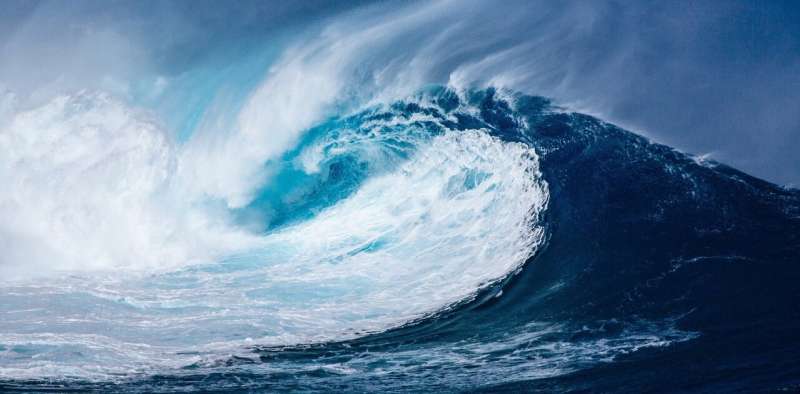Ocean spray is relatively lifeless: Sea spray study helps predict climate impact

When waves break on the open ocean, they throw particles called sea spray aerosols into the atmosphere. These particles can be lifted kilometers into the air, where they may affect how clouds form and therefore Earth's radiative balance. This balance between the amount of radiant energy Earth's surface and atmosphere emit, absorb, and reflect strongly affects climate.
Sea spray aerosols—the natural aerosol in Earth's atmosphere—are made up primarily of salt, but they can also contain traces of other chemical compounds, and even biologically produced proteins and sugars.
These molecules from ocean organisms may change how aerosols affect Earth's climate, and even plant and animal health, by modifying the particles' sizes, concentration, chemistry, and tendency to take up water. But previous studies haven't conclusively established average levels of organic content in sea spray.
Michael J. Lawler and colleagues address that shortcoming, using data from four deployments of the NOAA Particle Analysis by Laser Mass Spectrometry (PALMS) instrument during NASA's Atmospheric Tomography (ATom) mission over remote areas of the Atlantic and Pacific oceans between 2016 and 2018. The findings are in the journal AGU Advances.
PALMS measured the mass of organic molecules in the sampled aerosols, allowing the researchers to deduce the extent to which life influences the composition of sea spray aerosols.
They found that overall, the organic mass fraction of sea spray aerosols is low (less than 10% in most cases), though smaller particles had higher proportions of organics.
They also found little seasonal variability in the organic mass fraction, a strong sign that living organisms, the abundance of which waxes and wanes with the seasons, weren't much involved. Two exceptions were in the Canadian Arctic and the southern middle to high latitudes, where the researchers saw summertime maximums in the organic mass fraction.
The authors also found a much larger organic component of sea spray aerosols higher in the troposphere, which they say is likely because of atmospheric chemical reactions, not the original makeup of the aerosols emitted by ocean waves.
Future topics to be addressed include the role of organic molecules in the production of very small (smaller than 0.2 micrometer) sea spray aerosols, as well as better reconciling observations and numerical models of organics in sea spray aerosols.
More information: Michael J. Lawler et al, Sea Spray Aerosol Over the Remote Oceans Has Low Organic Content, AGU Advances (2024).
Journal information: AGU Advances
Provided by Eos
This story is republished courtesy of Eos, hosted by the American Geophysical Union. Read the original story .




















